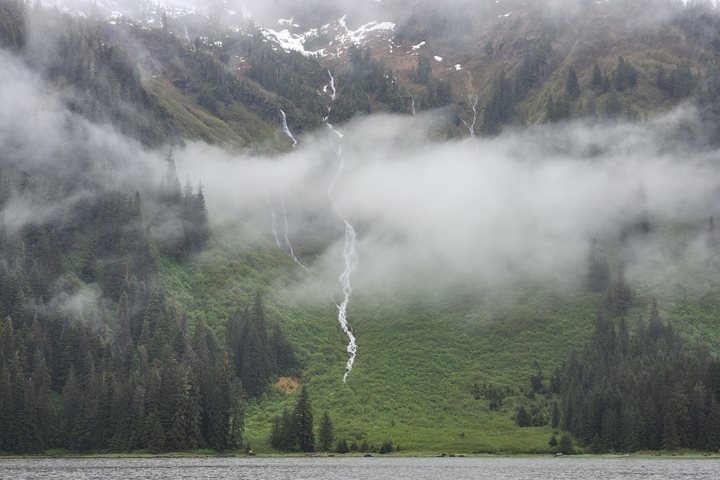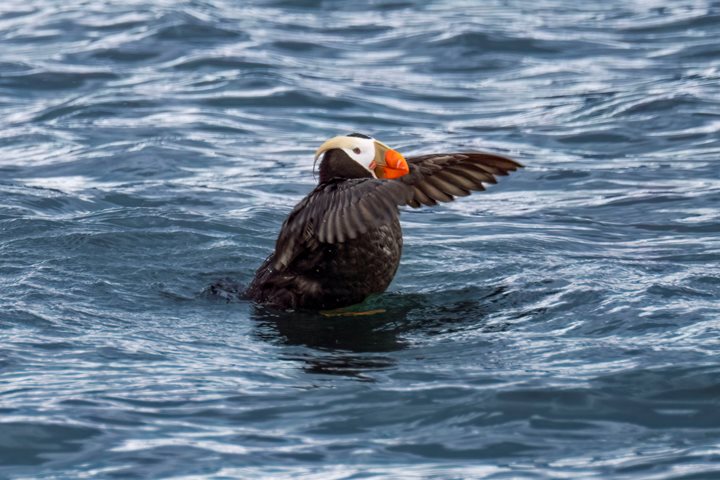We had a wonderful day! We were able to see an abundance of life in the Inian Islands! Whales came bursting from the sea below. These humpback whales can be up to 60 feet long. The whales push fish towards the shoreline so they can feed. Upwelling from below also pushes rockfish to the surface. Unable to decompress, the fishes’ eyes and bladders bulge, and the fish become food for the Steller sea lions feasting in the waters. The sea lions are all males, bulking up to become larger. Bulls can be up to 2500 pounds and eleven feet long. A series of birds feed on these fish. Bald eagles are the primary feeders. Juveniles have brown heads. As they mature, the feathers on their heads turn white, and their beaks turn yellow. We also saw pigeon guillemots and cormorants. These marine birds swarmed the island, and drifting around the rocks was another endearing surprise. Sea otters! Multiple sea otters were tied together to form what is called a raft. These sea otters have millions of hairs, so many that they do not need blubber or brown adipose fat to keep them warm. Later in the evening, guests entered Dundas Bay for a relaxing and meditative hike. Dundas is part of Glacier Bay National Park. Guests had the chance to kayak and Zodiac as well. During these amazing excursions, the undersea team collected footage that included marvelous views of massive ribbon kelp. The footage played during cocktail hour. Overall, it was an exceptional day!
- Daily Expedition Reports
- 20 Jun 2023
Inian Islands, 6/20/2023, National Geographic Quest
- Aboard the National Geographic Quest
- Alaska
Sierra Phillips, Naturalist/Expedition Diver
Sierra Phillips is a United Nations Youth Delegate and National Geographic Educator who received a master's degree in Exploration Sciences. Her training includes extensive work in marine biology/ecology, nautical archaeology, marine mammal care, shar...
Read MoreShare Report
Alaska's Inside Passage
VIEW ITINERARYRelated Reports
5/28/2025
Read
National Geographic Venture
Kelp Bay
Southeast Alaska’s rainforest was verdant in the morning rain. Small whitecaps textured the surface of the sea as we searched for marine life. Then, ahead in the distance, a big splash. Then another splash, followed by another. The bridge team expertly moved our ship closer. The young humpback whale had unlimited energy for throwing itself out of the water and flopping back in. We watched this youngster breach over and over until we needed to be on our way. Our next off-vessel excursion was on Baranof Island in Kelp Bay. Bushwhackers and moderate hikers passed along animal trails, climbing through Sitka spruces and western hemlocks. Giant bear’s bread fungus sprouted from downed trees. Delicate flowers, including Jeffrey Shooting Stars, decorated the path. We made our way to the boggy muskeg where few trees survive the wet environment. Streams of snowmelt and raindrops were occasionally blocked by the busy work of beavers. The forest was quiet and warm while hardy Zodiac cruisers toured the shoreline to view waterfalls and gulls hitching a ride on a floating log. Once back on board, we felt the warm comfort of the ship and came to realize that in just a few days, National Geographic Venture has come to feel like home.
5/27/2025
Read
National Geographic Quest
Glacier Bay National Park
A nice morning that only got better and prettier and sunnier! Truly a gift to bring guests here to witness the scale and diversity of ice and wildlife. South Marble Island had so many tufted puffins, and a few unexpected horned puffins, with sea lions and humpback whales galore. During lunch, we cruised up towards Margerie Glacier to view the impressive glacier and look for Arctic terns. Afterwards, we went past Gloomy Knob and saw mountain goats, looked for wildlife at Russel Cut (saw an osprey!), and ended the day with a stunning colorful sunset with an abundance of whales!







